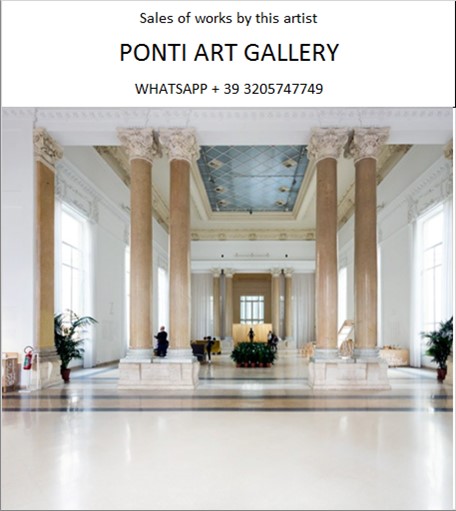Ponti Art Gallery is interested in buying and selling works
of art by this artist.

Raoul Dufy Biography
Raoul Dufy was a French artist whose vibrant, light-drenched canvases and innovative designs left an indelible mark on the 20th-century art world. Born on June 3, 1877, in Le Havre, France, Dufy was the eldest of a large family. His father, an accountant by profession, also served as a choirmaster and organist, which perhaps instilled in Dufy an early appreciation for the arts.
At the age of 14, Dufy began working for a coffee-importing company to help support his family. Despite the demands of his job, he was drawn to the arts and spent his free time drawing the harbor and ships he saw from his office window. Recognizing his talent, his father eventually enrolled him in evening classes at the École des Beaux-Arts in Le Havre. It was here that Dufy honed his skills in drawing and painting, and where he met his lifelong friend and fellow artist, Othon Friesz.
In 1900, Dufy's artistic promise was recognized with a municipal scholarship that allowed him to move to Paris and study at the prestigious École Nationale Supérieure des Beaux-Arts under the tutelage of Léon Bonnat. His early work was influenced by Impressionism, but a visit to the 1905 Salon des Indépendants would change the course of his career. There, he encountered the bold, expressive works of Henri Matisse and André Derain, members of the Fauvist movement, which inspired him to experiment with their vibrant color palette.
Dufy's Fauvist period was characterized by the use of bright, emotionally expressive tones. He exhibited with the Fauves in 1906 and 1907, but his style continued to evolve. In 1908, he worked with Georges Braque at L'Estaque, and for a brief period, his work reflected the structured compositions and subdued colors of Paul Cézanne, a post-Impressionist who had a significant retrospective that year. However, Dufy soon returned to a lighter, more carefree approach, developing a distinctive style marked by rapid, calligraphic drawing on backgrounds of bright, thinly washed color.
Throughout his career, Dufy remained a versatile artist, not only painting but also engaging in printmaking, book illustration, textile design, and even large-scale public decorations. His work in decorative arts began in earnest in 1912 when he started creating designs for a textile company. He produced a vast number of designs, around 4,000, for the Lyon-based textile company Bianchini Férier. His collaboration with the fashion designer Paul Poiret was also notable, as it allowed him to explore the intersection of art and fashion.
Dufy's paintings often depicted scenes of leisure and luxury, such as regattas, horse races, and musical events, capturing the spirit of the times with a sense of joy and celebration. His love for the color blue was particularly evident in his work, as he believed it maintained its character in all its tones. This affinity for blue is seen in his seascapes and urban landscapes, where the color often dominates the palette.
In the 1920s, Dufy's work became lighter and more animated, reflecting the joie de vivre of the post-war period. He continued to travel and paint scenes from the French Riviera to the Mediterranean, capturing the essence of these locales with his swift brushstrokes and radiant colors. His largest work, "La Fée Électricité," was completed for the 1937 International Exposition in Paris. This monumental mural celebrated the history of electricity and showcased Dufy's ability to blend mythology with modern science.
Despite suffering from rheumatoid arthritis in the 1950s, which greatly reduced his productivity, Dufy continued to paint, even strapping brushes to his hands to do so. His determination and passion for art never waned, and in 1952, he was awarded the International Grand Prize for Painting at the 26th Venice Biennale.
Raoul Dufy passed away on March 23, 1953, in Forcalquier, France, at the age of 75. He left behind a legacy of thousands of paintings, illustrations, ceramics, and textiles. His work continues to be celebrated for its contribution to Fauvism, Impressionism, and modern art, and is held in major collections worldwide, including the Museum of Modern Art in New York, the Musée d'Orsay in Paris, and the Hermitage Museum in St. Petersburg. Dufy's art, characterized by a sense of elegance and a celebration of life's pleasures, remains a testament to his belief that beauty and joy are integral to the human experience.
Raoul Dufy Quotes and Sales of
Works
Ponti Art Gallery selects and deals with paintings by the
artist. Upon request, we provide free estimates and
evaluations, communicate prices, quotations, and current
market values.
If you are interested in BUYING or SELLING works by the
artist, contact us immediately.
If you wish to sell or receive an evaluation of the
works:
Send us a frontal photo of the painting, one of the back,
and one of the signature. Also, indicate the dimensions of
the work. Inform us about the purchase origin of the work
and any kind of available documentation (purchase
receipts, certificates of authenticity, publications). One
of our operators will respond to you on the same day. We
guarantee maximum confidentiality and extreme
professionalism.
If you wish to purchase works by the painter: Contact us
and let us know your request. We will inform you about the
available works. We also offer the possibility to
subscribe to our NEWSLETTER, through which you will be
informed at the beginning of each month about the latest
acquisitions of the art gallery.
You can send us pictures of the work:
